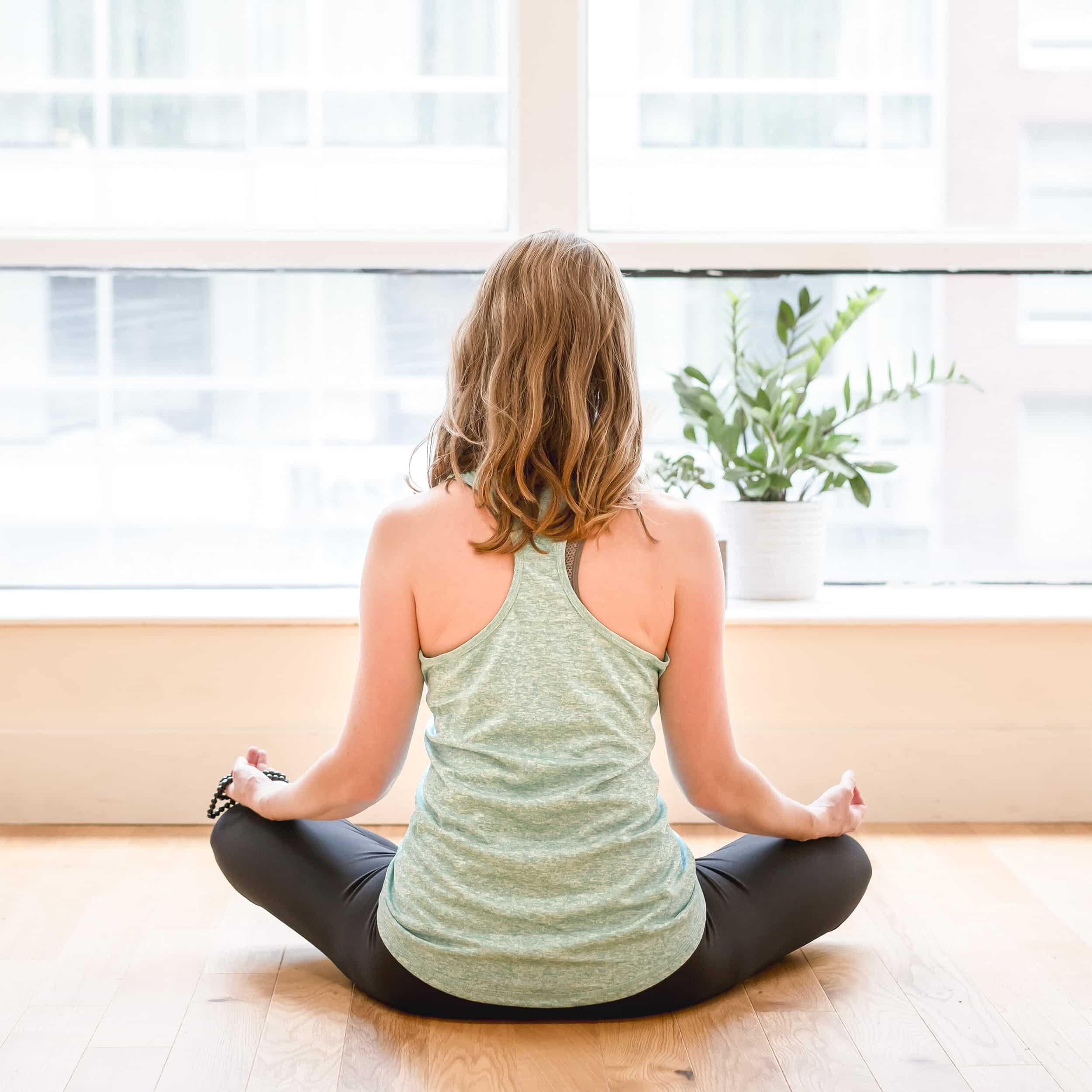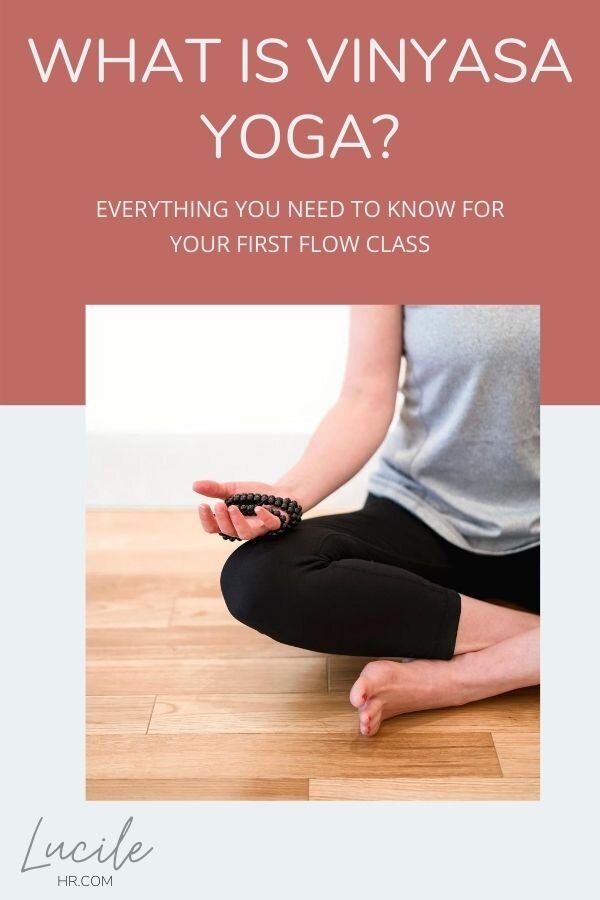What Is Vinyasa Yoga? Everything You Need To Know As A Vinyasa Yoga Beginner For Your First Flow Class
So you want to start doing Vinyasa Yoga on your own or at a studio but don’t really know what will happen in class? Or maybe you've heard of it and even have your first flow class programmed but don't know what to expect?
I am a Vinyasa Yoga teacher and I'm here to give you a bit of context before that first class so that you can fully enjoy it and not spend it wondering if you are doing something wrong!
I will answer all your most pressing questions, including what IS vinyasa yoga, and everything you need to know as a vinyasa yoga beginner like what to wear to class, what you will do and what to do if you can't do the postures. I've got you covered!
What is vinyasa yoga? What is flow yoga?
Both are the same thing: It is one of the main styles of yoga where you move from one pose to the next using the breath. It is often called flow because of the seamless way the poses are linked together, creating a flowing yoga sequence.
A very simple example of this synchronization between breath and movement is the beginning of a sun salutation, a common element of vinyasa yoga practice (more on that later!): as you inhale, you bring your arms up overhead, as you exhale, you fold forward, bending your knees, hands on the ground.
Each movement and breath is cued by the teacher, which also means you are fully guided during your vinyasa practice.
Table of Contents
What does vinyasa mean?
A bit more on the history of vinyasa yoga: Modern postural yoga, also called simply yoga as exercise has its roots in India but has been influenced by many teachers all over the world (more on vinyasa yoga schools soon!). Postures were not central to ancient yoga practices that were more meditative in nature.
What does Vinyasa Yoga mean?
Vinyasa yoga’s definition comes from the ancient Indian language Sanskrit: nyasa means “to place” and vi, “in a special way”. More concretely, this refers to the deliberate sequencing of the poses, that are aligned with the breath.
A complete definition of vinyasa yoga:
Here are the main characteristics of vinyasa yoga:
1. The poses are linked together
You are constantly moving with intention from a pose to another with skillful transitions. A lot of attention is set on the way you move in and out of the pose.
2. The breath is used to move mindfully
You move in accordance with the breath and its anatomy: for example, it is easier to inhale while back bending and easier to exhale while forward folding (try it out). You will also probably do breathing exercises.
3. It is more of a workout than other styles
It totally counts as cardio. This is because the poses are not held for a long time and you are almost constantly moving, going through dynamic vinyasa transitions.
4. It is a moving meditation and requires intense focus
Again, you are constantly moving and you can’t let your mind wander: focus on the poses or you’ll miss out on class! This is a great way to get started with a meditation practice.
5. It is a very creative style and each class is different
There are as many ways to teach vinyasa yoga as there are teachers. This can be a good thing since you can find a teacher that teaches exactly what you like. This can also be confusing as you’ll probably need to try out a few different studios and teachers to find one that fully resonates with you! Keep reading for an outline of the different types of classes!
This section will help you navigate the studio’s schedule to find the vinyasa yoga class that works for you. As I was telling you, it is a style with a wide variety of smaller styles or schools in it! This is why I recommend you look into who your teacher is and where they have trained before taking that first generic class or going to a studio from a specific vinyasa yoga school.
Types of vinyasa yoga classes
Here are a few of the many many vinyasa yoga methods or classes you can find at general studios:
Ashtanga yoga: an energetic style created by K. Pattabhi Jois with set series of poses.
Power Vinyasa Flow: a very dynamic style that will have you sweating! Ideal if you can’t sit still and need to use all the energy you have.
Slow flow: If you know you need to slow down to relax, you will love this gentle vinyasa yoga practice.
Meditative Flow: If you are coming to yoga to prepare yourself for meditation or are interested in the mental benefits of yoga, this one is for you.
Hot vinyasa yoga: A heated vinyasa class. I personally like infrared panels for a more bearable heat.
You will also find many styles branded by a studio or teacher:
Jivamukti: a vigorous physical practice combined with strong spiritual components
Modo Yoga: a hot yoga style focused on detoxification
Baptiste Yoga: a style of power vinyasa yoga
Strala Yoga: a very accessible and simple style of yoga
Here are a few surprising yoga classes you might try:
CorePowerYoga: Yoga with weights, in a heated room. This hardcore variant of yoga developed by CorePower is for you if you enjoy pushing yourself harder.
Chair Yoga: Ideal if you have an injury or a loss of mobility, chair yoga is an awesome way to start moving gently again. You’ll be surprised at everything you can do on a chair.
Desk yoga: This is yoga but… at your desk. If you like sneaking in a discrete workout while on the clock, this one is for you. There are many poses that you can practice while seated that will reverse the negative effects of a desk job.
Yoga with animals: you’ve probably heard about goat yoga by now? This is just a fun way to practice yoga with animals around you and use yoga as an opportunity to play with them.
Stand up paddle yoga: this one will challenge your balance big time! Balance is key to overall physical well being and being on the water is super relaxing.
Although I would recommend trying out a few beginners’ vinyasa yoga classes of the same type of yoga with different teachers, you should also make sure to be fully excited about your yoga practice! There are so many different styles of yoga, and you should try as many as you feel drawn to! If you don't fully resonate with a style or a teacher, try another one, there's something for everyone. If after a month of regular practice, you still don't find value in what you are practicing, it is a sign you need a switch!
Is vinyasa yoga for beginners?
Vinyasa yoga is for everyone, no matter your background, age, physical condition, weight… That said, going to a vinyasa class can be a bit intimidating when you are starting out (I’ve been there!). If you are into a very precise style or you are looking for a very gentle practice, vinyasa might not be for you. If you love a creative and fun style that will have you explore your body and mind, you’ll love it!
Assess your physical condition and choose your class from there! Here are a few things to look out for:
Fitness levels: are you very active or not at all? If you are not active start with a slow vinyasa flow class.
Injuries or existing conditions: you might want to consult with your doctor if you have injuries or medical conditions such as high blood pressure. Just know that you can still practice yoga but you need to tell your teachers and ask them for modifications. I recommend hiring a private yoga instructor for a few sessions to learn about modifications. You will be surprised at what you can do, from doing yoga without bearing weight on the hands at all to never having your head down or just learning to protect your low back, the possibilities are endless!
Are you pregnant? We often hear yoga is awesome for pregnant women. It is, but just don’t go to a random open level class. Start with learning the right modifications for yourself and your baby, trimester by trimester.
My point of view on vinyasa yoga as a yoga teacher
I teach vinyasa yoga online and in person. I believe this style can be one of the most approachable and fun for beginners as you are fully guided in each posture and are working your body through smooth transitions into postures you didn’t know you were capable of, which is incredibly rewarding.
Since there is a lot of variety, it can also be a bit confusing to navigate as a beginner. This confusion can lead to injuries if you are unsure of how to do the poses or modify them for your body.
I recommend you also take some time to learn on your own, either with a private teacher or a guide to understanding how to make yoga work for your own body.
Everything you need to know as a vinyasa yoga beginner for your first flow class
So you’ve decided to try your first class! Congratulations. Whether you go to a studio or decide to practice vinyasa yoga at home with an online course or teacher, here is what to expect in a vinyasa yoga beginner class.
What to wear to yoga class and bring
1. Yoga clothing
You should wear comfortable clothing that allows you to move freely. You will be taking your shoes, leaving them at the door of the studio and practice barefoot, without socks. Remember that you will be putting your body in a wide range of positions so you might want to make sure you have enough coverage and for example, don’t go commando with loose clothing, or your neighbor might get a little more than asked for.
2. A yoga mat
Bring your own or rent one.
3. A water bottle
It might seem obvious but drink plenty of water before and after class and avoid drinking coffee or alcohol before a class as this will disturb your energy.
Protect the environment and bring your own water bottle. Protect your body against endocrine disruptors and don’t drink out of plastic either.
Main vinyasa yoga asanas (poses)
This is THE section to read if you don’t want to be surprised by your first class or want to understand exactly what you are doing in class! Here is what you will find in almost every class:
1. Sun Salutation Variations:
Sun Salutations are a series of postures that are essential to this practice. There are many variations and each teacher makes their own or builds a sequence on top of them.
Sun Salutation A consists of these poses: Standing - Forward fold - Half-pushup - Upward facing dog (backbend) - Downward facing dog
Here is why Sun Salutations are so important in this style of yoga:
They are a complete sequence in itself: Sun Salutations stretch the entire front and back of the body and build strength as well.
They link breath and movement: They are a great way to build awareness of the relationship between your body and the breath
They are the perfect warmup: They are energizing and still the mind while preparing the body for other postures
2. The main groups of poses:
A flowing vinyasa yoga sequence skillfully mixes some or all of these poses:
Reclined poses, on your belly or on your back
Neutralizers: they are so important to move with ease between poses, especially between backbends and forward bends.
Inversions (optional): Balanced inversions tend to be scary when starting out, practice them at the wall or with the help of your teacher.
Savasana: the part where you lay down at the end, which can be challenging for some people.
As you can see, this is a wide range of vinyasa yoga poses and while this can seem a lot it is important to regularly practice a lot of different poses if you want to progress at yoga. Each one has unique benefits and works different parts of the body in different ways.
Each pose also has different variations: they might look different but they are actually working the same thing. I encourage you to explore yoga beginner poses by starting with the variation that feels good for you and in which you can breathe easily. For example, if you can’t do the splits (I personally can’t!), you can practice runner’s lunge and half-splits for similar benefits! If you want to learn more about vinyasa yoga benefits go check out this article.
3. Smooth transitions
Vinyasa classes are heavy on transitions! You will be moving consciously in and out of poses, which is essential to building mindfulness. The transition and the way you come in and out of a pose is as important as the pose itself. It should also be linked with the breath. Don’t worry too much about these in the beginning, the teacher will cue them entirely.
What does it mean to take a vinyasa?
A vinyasa, also called a flow, is a series of postures often used as a transition in yoga. It is used to bring the body back to balance before starting a new series of postures or doing the other side of the body.
There are several ways of taking vinyasa yoga flows for beginners:
Chaturanga (half push up), upward facing dog (backbend), downward facing dog (forward bend): if you are a beginner you will avoid practicing this one without the guidance of a teacher.
Lowering from plank to the ground, cobra (gentle backbend), downward facing dog (forward bend): this one is a safe choice for most people and a good beginner sequence.
Skipping it: you don’t have to take a flow every time the teacher cues it. You can skip it and rest in child’s pose, I actually encourage you to do it if you are feeling tired in class, to not over-exert yourself.
Not to be confused with the vinyasa yoga style.
Beginner tips for your first yoga class
Treat it as a learning experience: Explore what feels right for your unique self. How does your body feel in certain poses? Is one side easier than the other? How does your mind feel?
Focus on how the pose feels not on how the pose looks: There's no room for comparison on the mat! You know what happens if you finally manage to do this complicated pose you've seen all over Instagram? Nothing. Take the option that feels good for your body and if it hurts don’t do it!
Don't forget to breathe! If you have to only do one thing in your first yoga class, just breathe!
Prepare for it: know your body and if you have injuries or are pregnant, don’t forget to tell the teacher, they will give you modifications.
Basic vinyasa is not necessarily easy! Starting yoga is sometimes harder than it seems.
What happens to your body when you do yoga for the first time?
You will discover muscles you previously ignored the existence of: Yoga is a full-body workout and you will be sore in places you've never imagined before!
You will learn how to use your body properly: Did you know you had been sitting and standing wrong all this time? Yoga will help you find the right postural alignment in everyday situations such as standing or sitting at your desk.
Your body will feel more open: you don't have to be flexible to do yoga, yoga is what makes you more flexible!
I hope you enjoyed reading this article about vinyasa yoga for beginners and you finally know exactly what is vinyasa flow yoga.





